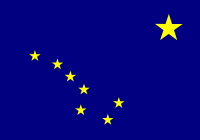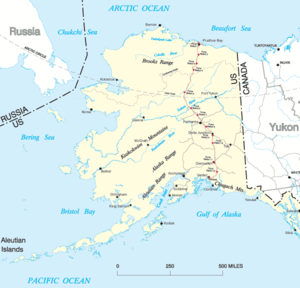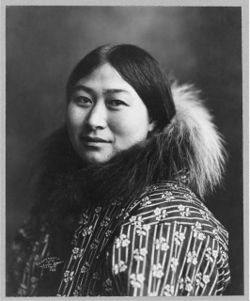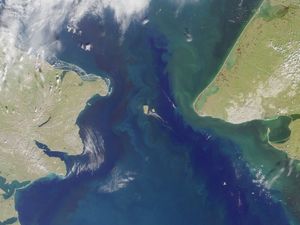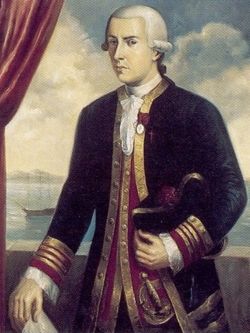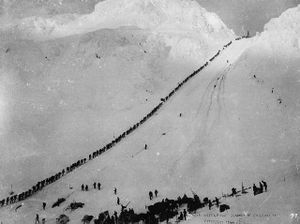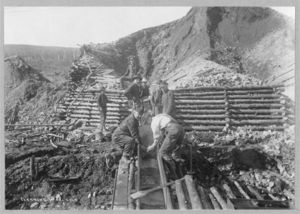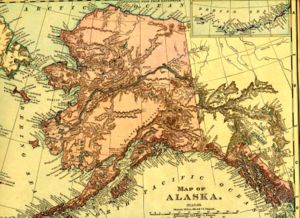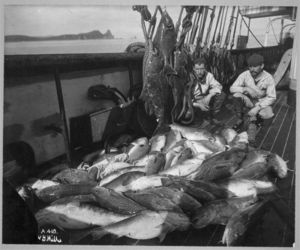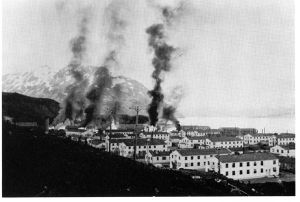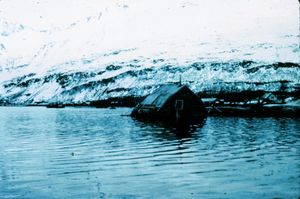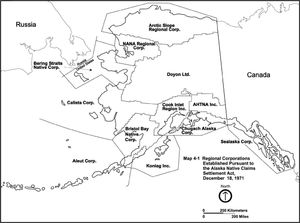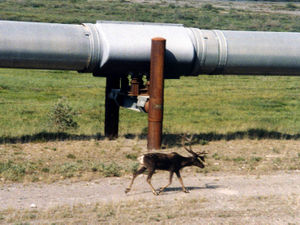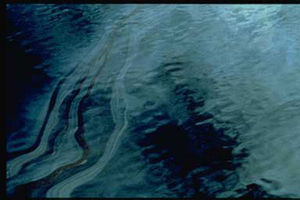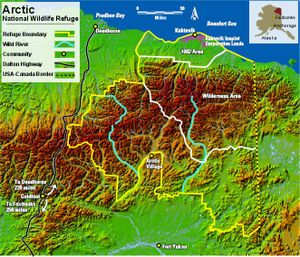History of Alaska
2007 Schools Wikipedia Selection. Related subjects: North American History
The history of Alaska (as part of the United States) began in 1867, but settlement of the region dates back to the end of the Upper Paleolithic Period (around 12,000 BCE). The earliest inhabitants were Asiatic groups who crossed the Bering Land Bridge into what is now western Alaska. Many, if not most, of the pre-Columbian peoples of the Americas crossed the land bridge before migrating south. At the time of European contact by the Russian explorers, the area was populated by the Inuit and a variety of other Indigenous groups.
The name "Alaska" is most likely derived from the Aleut word Alyaeska, meaning greater land as opposed to the Aleut word Aleutia, meaning lesser land. To the Aleuts, this distinction was a linguistic variation distinguishing the mainland from an island.
Most of Alaska's documented history dates from European settlement, starting with Vitus Bering, a Danish navigator in the service of the Russian Navy aboard the St. Peter. However, Aleksei Chirikov, commanding the St. Paul, made landfall first at the present-day site of Sitka on July 15, 1741. The Russian-American Company soon began hunting the otters and helping to colonize much of coastal Alaska, but the colony was never profitable, due mainly to high shipping costs.
William H. Seward, the U.S. Secretary of State, engineered the Alaskan purchase in 1867 for $7.2 million. The nearby Yukon Territory in Canada and Alaska itself were the site of a gold rush in the 1890s, and they remained a significant source of mining even after gold reserves diminished. On July 7, 1958 President Dwight D. Eisenhower signed the Alaska Statehood Act into law which paved the way for Alaska's admission into the Union as the 49th State on January 3, 1959.
The " Good Friday Earthquake" of March 27, 1964, registering 9.2 on the Richter scale, killed 131 people and leveled several villages. Oil revenues helped reestablish the population and infrastructure of the State after deposits were discovered in 1968, and after the Trans-Alaskan Pipeline was completed in 1977. In 1989, the Exxon Valdez hit a reef in the Prince William Sound, spilling between 11 and 35 million US gallons (42,000 and 130,000 m³) of crude oil over 1,100 miles (1,600 km) of coastline. Today, more than half of Alaskan land is owned by the Federal Government. The fates of the large reserves of wild frontier in the State are under debate, as is the highly political conflict over oil drilling in the Arctic National Wildlife Refuge.
Prehistory
- Paleolithic era
Paleolithic families moved into northwestern North America sometime between 16,000 and 10,000 BCE across the Bering Land Bridge in western Alaska. They found their passage blocked by a huge sheet of ice until a temporary recession in the last ice age that opened up an ice-free corridor through northwestern Canada, allowing bands to fan out throughout the rest of the continent. Eventually, Alaska became populated by the Inuit and a variety of Native American groups. Today, early Alaskans are divided into several main groups: the Southeastern Coastal Indians (the Tlingit, Haida, and Tsimshian), the Athabascans, the Aleut, and the two groups of Inupiat and Yup'ik .
The Tlingit, Haida, and Athabascans would hold potlatchs in which a person in a position of power would give away all of his possessions, have them eaten, or destroyed. At these potlatches, family histories would be recited, ceremonial titles would be transferred, and offerings would be given to ancestors. The Aleut society was divided into three categories: honorables, comprising the respected whalers and elders; common people; and slaves. At death, the body of an honorable was mummified, and slaves were occasionally killed in honour of the deceased. Means of hunting for these groups included snares, clubs, spears, and bows and arrows.
18th century
Russian Alaska
The first written accounts indicate that the first Europeans to reach Alaska came from Russia. The legend holds that a Russian settlement was established as early as 1648, when Semyon Dezhnev, a Siberian explorer, and Fedot Alekseev, a Russian merchant, began exploring the region, though there is little existing evidence to back up this claim. Vitus Bering, a Danish navigator in the service of the Russian Navy aboard the St. Peter, is often credited with the European 'discovery' of Alaska. In June 1741, the St. Peter, captained by Bering, and the St. Paul, captained by a Russian, Aleksei Chirikov, set sail from Russia at the Siberian port of Petropavlovsk .
Aleksei Chirikov, commanding the St. Paul, made landfall first at the present-day site of Sitka on July 15, 1741. After surviving a shipwreck, Bering's crew returned to Russia from North America with what were judged to be the finest otter furs in the world. The Russian-American Company soon began hunting the otters and helping to lightly colonize much of coastal Alaska, but shipping costs meant that the colony was never profitable. Georg Wilhelm Steller, the ship's naturalist, hiked along the island and took notes on the plants and wildlife.
Subsequently, small associations of fur traders began to sail from the shores of Siberia towards the Aleutian islands. As the runs from Siberia to America became longer expeditions (lasting two to four years or more), the crews established hunting and trading posts. By the late 1790s, these had become permanent settlements. Approximately half of the fur traders were Russians from various European parts of the Russian Empire or from Siberia. The others were indigenous people from Siberia or Siberians with mixed indigenous, European and Asian origins.
Catherine the Great, who became Czarina in 1762, proclaimed good will toward the Aleuts and urged her subjects to treat them fairly. On some islands and parts of the Alaska Peninsula, groups of traders had been capable of relatively peaceful coexistence with the local inhabitants. Other groups could not manage the tensions and perpetrated exactions. The growing competition between the trading companies, merging into fewer, larger and more powerful corporations, created a conflictual situation that aggravated the relations with the indigenous populations. Over the years, the situation became catastrophic.
As the animal populations declined, the Aleuts, already too dependent on the new barter economy created by the Russian fur trade, were increasingly coerced into taking greater and greater risks in the highly dangerous waters of the North Pacific to hunt for more otters. As the powerful Shelikhov-Golikov Company established itself as a monopoly, skirmishes and violent incidents turned into systematic violence as a tool of colonial exploitation of the indigenous people (the Company's propaganda in Russia blaming its competitors for its own violent actions is the main reason why the earlier period of Russian-indigenous relations has been viewed almost exclusively as a genocide).
In 1784, Grigory Ivanovich Shelikhov, the co-founder of what was to become the Russian–American Company that colonized early Alaska, arrived in Three Saints Bay on Kodiak Island with two ships, the Three Saints and the St. Simon . The indigenous Koniag harassed the Russian party and Shelikhov responded by killing hundreds and taking hostages to enforce the obedience of the rest. Having established his authority on Kodiak Island, Shelikhov founded the first permanent Russian settlement in Alaska on the island's Three Saints Bay, built a school to teach the natives to read and write Russian, and introduced the first resident missionaries and clergymen who spread the Russian Orthodox religion.
This religion (with its rituals and sacred texts, translated into Aleut at a very early stage) had been informally introduced, in the 1740s-1780s, by the fur traders who founded local families or symbolically adopted Aleut trade partners as godchildren to gain their loyalty through this special personal bond. The missionaries soon opposed the exploitation of the indigenous populations and their reports remain one of our main sources on the violence exercised to establish colonial rule in this period.
In 1790, Shelikhov, back in Russia, hired Alexandr Baranov to manage his Alaskan fur enterprise. Baranov, concerned by the sight of non-Russian Europeans trading with the Natives in southeast Alaska, established Mikhailovsk six miles (10 km) north of present-day Sitka in 1795. By 1804, Alexandr Baranov, now manager of the Russian–American Company, had consolidated the company's hold on fur trade activities in the Americas following his victory over the local Tlingit clan at the Battle of Sitka. However, profits began to fall due to overhunting and dependence on American supply ships. Rather than let the British take over the region, Russian America was sold to the U.S., and all the holdings of the Russian–American Company were liquidated.
The most visible trace of the Russian colonial period in contemporary Alaska is the presence of nearly ninety Russian Orthodox parishes with a membership of over 20, 000 men, women, and children, almost exclusively indigenous people, including several Athabascan groups of the interior, very large Yup'ik communities, and the quasi-totality of the Aleut and Koniag populations. Among the few Tlingit Orthodox parishes, the large group in Juneau adopted Orthodox Christianity only after the Russian colonial period, in an area where there had been no Russian settlers nor missionaries. What probably explains such an extent of a local Russian Orthodox tradition and its persistence is the merger of local cultures and Christian beliefs and rituals. It is a situation comparable in many aspects to the history of Latin American Catholicism.
Inspired by the same pastoral theology as Bartolomé de las Casas or St. Francis Xavier, the origins of which come from early Christianity's need to adapt to the cultures of Antiquity, missionaries in Russian America applied a strategy that placed value on local cultures and encouraged indigenous leadership in parish life and missionary activity. This cultural policy was originally intended to gain the loyalty of the indigenous populations by establishing the authority of Church and State as protectors of over 10,000 inhabitants of Russian America (where the number of ethnic Russian settlers had always been less than the record 812, almost all concentrated in Sitka and Kodiak).
A side effect of the missionary strategy was to generate a new and autonomous form of indigenous identity, allowing many native traditions to survive in local "Russian" Orthodox tradition and in the religious life of the villages. Part of this modern indigenous identity is an alphabet and the basis for a written literature in almost each of the ethnic-linguistic groups in the Southern half of Alaska.
Spain's attempts at colonization
Spanish claims to Alaska dated to the papal bull of 1493, which divided the entire globe into Spanish and Portuguese hemispheres for the purpose of establishing colonies. The entire west coast of North America was within the portion of the globe granted to Spain. In 1513, this claim was reinforced by Vasco Núñez de Balboa, the Spanish explorer, when he claimed all lands adjoining the Pacific Ocean for the Spanish Crown. Spain was sufficiently confident in these claims, that it took little or no action to actually colonize the claimed territory north of Mexico for over 250 years.
However, by the 1770s, rivals began to appear for the first time in the form of British and Russian fur traders, and King Charles III of Spain sent forth from Mexico a number of expeditions between 1774 and 1791, to re-assert historic Spanish claims, and to explore the northern Pacific Coast of North America, including Alaska.
The second expedition, led by Lieutenant Bruno de Hezeta aboard the Santiago, along with 90 men set sail from San Blas on March 16, 1775 with orders to make clear Spanish claims for the entire northern Pacific Coast. Accompanying Hezeta was the escort and supply ship Nuestra Señora de Guadalupe (generally known as the Señora), initially under the command of Juan Manuel de Ayala. The 37 foot (11 m) schooner and its crew complement of 16 were to perform coastal reconnaissance and mapping, and could make landfall in places the larger Santiago was unable to approach on its previous voyage; in this way, the expedition could officially reassert Spanish claims to the lands north of Mexico it visited.
The two ships sailed together as far north as Point Grenville, Washington, named Punta de los Martires (or "Point of the Martyrs") by Hezeta in response to an attack by the local Quinault Indians. By design, the vessels parted company on the evening of July 29, 1775 with the Santiago continuing to what is today the border between Washington state and Canada. The Señora (now with second officer Juan Francisco de la Bodega y Quadra at the helm) moved up the coast according to its orders, ultimately reaching a position at Latitude 59° North on August 15, entering Sitka Sound near the present-day town of Sitka, Alaska. It is there that the Spaniards performed numerous "acts of sovereignty," naming and claiming Puerto de Bucareli ( Bucareli Sound), Puerto de los Remedios, and Mount San Jacinto, renamed Mount Edgecumbe by British explorer James Cook three years later.
Throughout the voyage, the crews of both vessels endured many hardships, including food shortages and scurvy. On September 8, the ships rejoined and headed south for the return trip to San Blas.
Another expedition was that of Alessandro Malaspina. In 1791, the King of Spain gave Alejandro Malaspina command of an around-the-world scientific expedition, with orders to locate the Northwest Passage and search for gold, precious stones, and any American, British, or Russian settlements along the northwest coast. He surveyed the Alaska coast to the Prince William Sound. At Yakutat Bay, the expedition made contact with the Tlingit. Spanish scholars made a study of the tribe, recording information on social mores, language, economy, warfare methods, and burial practices. Artists with the expedition, Tomas de Suria and José Cardero, produced portraits of tribal members and scenes of Tlingit daily life. A glacier between Yakutat Bay and Icy Bay was subsequently named after Malaspina.
In the end, the North Pacific rivalry proved to be too difficult for Spain, which withdrew from the contest and transferred its claims in the region to the United States in the Adams-Onís Treaty of 1819. Today, Spain's Alaskan legacy endures as little more than a few place names, among these the Malaspina Glacier and the town of Valdez.
Britain's presence
British settlements in Alaska consisted of a few scattered trading outposts, with most settlers arriving by sea. Captain James Cook, midway through his third and final voyage of exploration in 1778, sailed along the west coast of North America aboard the HMS Resolution, mapping the coast from the state of California all the way to the Bering Strait. During the trip, he discovered what came to be known as Cook Inlet (named in honour of Cook in 1794 by George Vancouver, who had served under his command) in Alaska. The Bering Strait proved to be impassable, although the Resolution and its companion ship HMS Discovery made several attempts to sail through it. The ships left the straits to return to Hawaii in 1779.
Cook's expedition spurred the British to increase their sailings along the northwest coast, following in the wake of the Spanish. Three Alaska-based posts, funded by the Hudson's Bay Company, operated at Fort Yukon, on the Stikine River, and in Wrangell (the only Alaskan town to have been the subject of British, Russian, and American rule) throughout the early 1800s.
19th century
Russia-American agreement
Financial difficulties in Russia, the desire to keep Alaska out of British hands, and the low profits of trade with Alaskan settlements all contributed to Russia's willingness to sell its possessions in North America. At the instigation of U.S. Secretary of State William Seward, the United States Senate approved the purchase of Alaska from Russia for $7,200,000. (approximately $90,750,000 in 2005 dollars, adjusted for inflation) on 9 April 1867. This purchase was popularly known in the U.S. as "Seward's Folly", or "Seward's Icebox", and was unpopular at the time, though the later discovery of gold would show it to be a worthy one. The nearby Yukon Territory in Canada and Alaska itself were the site of a gold rush in the 19th century, and they remained a significant source of mining even after gold reserves diminished.
In Soviet Union there existed a myth that Alaska was rented to the United states for 99 (or 100) years, rather than sold. The myth still perpetuates in Russia, in addition to other versions of events, such as the deal was a result of bribery, of American pressure, or even American manipulation with the stocks of the Russian American Company.
The Department of Alaska
The United States flag was raised on 18 October 1867 (now called Alaska Day). Coincident with the ownership change, the de facto International Date Line was moved westward, and Alaska changed from the Julian calendar to the Gregorian calendar. Therefore, for residents, Friday, October 6, 1867 was followed by Friday, October 18, 1867—two Fridays in a row because of the date line shift.
During the Department era, from 1867 to 1884, Alaska was variously under the jurisdiction of the U.S. Army (until 1877), the United States Department of the Treasury (from 1877 until 1879) and the U.S. Navy (from 1879 until 1884).
When Alaska was first purchased, most of its land remained unexplored. In 1865, Western Union laid a telegraph line across Alaska to the Bering Strait where it would connect, under water, with an Asian line. It also conducted the first scientific studies of the region and produced the first map of the entire Yukon River. The Alaska Commercial Company and the military also contributed to the growing exploration of Alaska in the last decades of the 1800s, building trading posts along the Interior's many rivers.
District of Alaska
In 1884, the region was organized and the name was changed from the Department of Alaska to the District of Alaska. At the time, legislators in Washington, D.C., were occupied with post-Civil War reconstruction issues, and had little time to dedicate to Alaska. In 1896, the discovery of gold in Yukon Territory in neighboring Canada, brought many thousands of miners and new settlers to Alaska, and literally overnight, ended the nation's four year economic depresson. Although it was uncertain whether gold would also be found in Alaska, Alaska greatly profited because it was along the easiest transportation route to the Yukon goldfields. Numerous new cities, such as Skagway, Alaska, owe their existence to a gold rush in Canada. No history of Alaska would be complete without mention of Soapy Smith, the crime boss confidence man who operated the largest criminal empire in gold rush era Alaska, until he was shot down by vigilantes. Today, he is known as "Alaska's Outlaw."
In 1899, gold was found in Alaska itself in Nome, and several towns subsequently began to be built, such as Fairbanks and Ruby. In 1902, the Alaska Railroad began to be built, which would connect from Seward to Fairbanks by 1914, though Alaska still does not have a railroad connecting it to the lower 48 states today. Still, an overland route was built, cutting transportation times to the contiguous states by days. The industries of copper mining, fishing, and canning began to become popular in the early 1900s, with 10 canneries in some major towns.
20th century
Alaska Territory
By the turn of the 20th century, commercial fishing was gaining a foothold in the Aleutian Islands. Packing houses salted cod and herring, and salmon canneries were opened. Another traditional occupation, whaling, continued with no regard for over-hunting. They pushed the bowhead whales to the edge of extinction for the oil in their tissue (though in recent years, due to a decline in commercial whaling, their populations have rebounded enough for Natives to harvest many each year without affecting the population). The Aleuts soon suffered severe problems due to the depletion of the fur seals and sea otters which they needed for survival. As well as requiring the flesh for food, they also used the skins to cover their boats, without which they could not hunt. The Americans also expanded into the Interior and Arctic Alaska, exploiting the furbearers, fish, and other game on which Natives depended.
When Congress passed the Second Organic Act in 1912, Alaska was reorganized, and renamed the Territory of Alaska. By 1916, its population was about 58,000. James Wickersham, a Delegate to Congress, introduced Alaska's first statehood bill, but it failed to due lack of interest from Alaskans. Even President Harding's visit in 1923 could not create widespread interest in statehood. Under the conditions of the Second Organic Act, Alaska had been split into four divisions. The most populous of the divisions, whose capital was Juneau, wondered if it could become a separate state from the other three. Government control was a primary concern, with the territory having 52 federal agencies governing it.
Then, in 1920, the Jones Act required U.S.-flagged vessels to be built in the United States, owned by U.S. citizens, and documented under the laws of the United States. All goods entering or leaving Alaska had to be transported by American carriers and shipped to Seattle prior to further shipment, making Alaska dependent on Washington. The U.S. Supreme Court ruled that the provision of the Constitution saying one state should not hold sway over another's commerce did not apply because Alaska was only a territory. The prices Seattle shipping businesses charged began to rise to take advantage of the situation.
The Depression caused prices of fish and copper, which were vital to Alaska's economy at the time, to decline. Wages were dropped and the workforce decreased by more than half. In 1935, President Franklin Delano Roosevelt thought Americans from agricultural areas could be transferred to Alaska's Matanuska-Susitna Valley for a fresh chance at agricultural self-sustainment. Colonists were largely from northern states, such as Michigan, Wisconsin, and Minnesota under the belief that only those who grew up with climates similar to that of Alaska's could handle settler life there. The United Congo Improvement Association asked the president to settle 400 African-American farmers in Alaska, saying that the territory would offer full political rights, but racial prejudice and the belief that only those from northern states would make suitable colonists caused the proposal to fail.
The exploration and settlement of Alaska would not have been possible without the development of the aircraft, which allowed for the influx of settlers into the state's interior, and rapid transportation of people and supplies throughout. However, due to the unfavorable weather conditions of the state, and high ratio of pilots-to-population, over 1700 aircraft wreck sites are scattered throughout its domain. Numerous wrecks also trace their origins to the military build-up of the state during both World War II and the Cold War.
World War II
During World War II, the three of the outer Aleutian Islands—Attu, Agattu and Kiska—were the only part of the United States to have land occupied by the enemy during the war. The Japanese launched the campaign mostly as a distraction to battles taking place in other parts of the Pacific, but also intended to use the islands as a base for launching a campaign against the contiguous U.S. The battle became a matter of national pride, defending the nation against the first foreign military campaign on U.S. soil since the War of 1812.
On June 3, 1942 the Japanese launched an air attack on Dutch Harbour, a U.S. naval base on Unalaska Island . U.S. forces managed to hold off the planes, and the base survived this attack, and a second one, with minor damage. On June 7, the Japanese landed on the islands of Kiska and Attu, where they overwhelmed Attu villagers. The villagers were taken to Japan and interned for the remainder of the war. Aleuts from the Pribilofs and Aleutian villages were then evacuated by the United States to Southeast Alaska.
In the fall of 1942, the U.S. Navy began constructing a base on Adak, and on May 11, 1943, American troops landed on Attu, determined to retake the island . The battle wore on for more than two weeks. The Japanese, who had no hope of rescue because their fleet of transport submarines had been turned back by U.S. destroyers, fought to the last man. The end finally came on May 29 when the Americans repelled a banzai charge. Some Japanese remained in hiding on the small island for up to three months after their defeat. When discovered, they killed themselves rather than surrender. There were 3,929 American casualties; 549 were killed, 1148 were injured, 1200 had severe cold injuries, 614 succumbed to disease, and 318 died of miscellaneous causes, largely Japanese booby traps and friendly fire.
The U.S. then turned its attention to the other occupied island, Kiska. From June through August, tons of bombs were dropped on the tiny island. The Japanese, under cover of thick Aleutian fog, escaped via transport ships. After the war, the Native Attuans who had survived internment in Japan were resettled to Atka by the federal government, which considered their home villages too remote to defend.
As a result of World War II, the construction of the Alaska–Canada Military Highway was completed in 1942 to form an overland supply route to America's Russian allies on the other side of the Bering Strait. Running from Great Falls, Montana, to Fairbanks, the road was the first stable link between Alaska and the rest of America. The construction of military bases also contributed to the population growth of some Alaskan cities. Anchorage almost doubled in size, from 4,200 people in 1940 to 8,000 in 1945.
Statehood
By the turn of the 20th century, a movement pushing for Alaska statehood began, but in the contiguous 48 states, legislators were worried that Alaska's population was too sparse, distant, and isolated, and its economy was too unstable for it to be a worthwhile addition to the United States . World War II and the Japanese invasion highlighted Alaska's strategic importance, and the issue of statehood was taken more seriously, but it was the discovery of oil at Swanson River on the Kenai Peninsula that dispelled the image of Alaska as a weak, dependent region. President Dwight D. Eisenhower signed the Alaska Statehood Act into United States law on 7 July 1958, which paved the way for Alaska's admission into the Union on January 3, 1959. Juneau, the territorial capital, continued as state capital, and William A. Egan was sworn in as the first governor.
Alaska has no counties as in the case of other states of the United States. Instead, the state is divided into 27 census areas and boroughs. The difference between boroughs and census areas is that boroughs have an organized area-wide government, while census areas are artificial divisions defined by the United States Census Bureau for statistical purposes only. Areas of the state not in organized boroughs compose what the government of Alaska calls the "unorganized borough". Borough-level government services in the "unorganized borough" are provided by the state itself.
The "Good Friday Earthquake"
On March 27, 1964 the " Good Friday Earthquake" struck South-central Alaska, churning the earth for four minutes with a magnitude of 9.2. The earthquake was one of the most powerful ever recorded and killed 131 people . Most of them were drowned by the tsunamis that tore apart the towns of Valdez and Chenega. Throughout the Prince William Sound region, towns and ports were destroyed and land was uplifted or shoved downward. The uplift destroyed salmon streams, as the fish could no longer jump the various newly created barriers to reach their spawning grounds. Ports at Valdez and Cordova were beyond repair, and the fires destroyed what the mudslides had not. At Valdez, an Alaska Steamship Company ship was lifted by a huge wave over the docks and out to sea, but most hands survived. At Turnagain Arm, off Cook Inlet, the incoming water destroyed trees and caused cabins to sink into the mud. On Kodiak, a tidal wave wiped out the villages of Afognak, Old Harbour, and Kaguyak and damaged other communities, while Seward lost its harbour.
Alaska Native Claims Settlement Act
Despite the extent of the catastrophe, Alaskans rebuilt many of the communities. In the mid-1960s, Alaska Natives had begun participating in the state and local government. More than 200 years after the arrival of the first Europeans, Natives from all ethnic groups united to claim title to lands wrested from them. The government responded slowly, until, in 1968, the Atlantic-Richfield Company discovered oil at Prudhoe Bay on the Arctic coast, catapulting the issue of land ownership into headlines. In order to lessen the difficulty of drilling at such a remote location and transporting the oil to the lower 48 states, the best solution seemed to be building a pipeline to carry the oil across Alaska to the port of Valdez, built on the ruins of the previous town. At Valdez, the oil would be loaded onto tanker ships and sent by water to the contiguous states. The plan was approved, but a permit to construct the pipeline, which would cross lands involved in the native dispute, could not be granted until the Native claims had been settled.
With major petroleum dollars on the line, there was a new urgency for an agreement, and, in 1971, the Alaska Native Claims Settlement Act was signed into law by the U.S. President, under which the Natives relinquished aboriginal claims to their lands . In return, they received access to 44 million acres (180,000 km²) of land and were paid $963 million. The land and money were divided among regional, urban, and village corporations. Some handled their funds wisely and others did not, leaving some Natives land rich and cash poor. The settlement compensated the Natives for the invasion of their lands and opened the way for all Alaskans to profit from oil, the state's largest natural resource.
The Trans-Alaskan Pipeline
Between Arctic Alaska and Valdez, there were three mountain ranges, active fault lines, miles of unstable, boggy ground underlain with frost, and migration paths of caribou and moose. To counteract the unstable ground and animal crossings, half the 800-mile (approximately 1,300 km) pipeline is elevated on supports high enough to keep it from melting the permafrost and destroying natural terrain . To help the pipeline survive an earthquake, it was laid out in a zigzag pattern, so that it would roll with the earth instead of breaking up. The first oil arrived at Valdez on July 28, 1977. The total cost of the pipeline and related projects, including the tanker terminal at Valdez, 12 pumping stations, and the Yukon River Bridge, was $8 billion.
As the oil bonanza took shape, per capita incomes rose throughout the state, with virtually every community benefiting. State leaders were determined that this boom would not end like the fur and gold booms, in an economic bust as soon as the resource had disappeared. In 1976, the people of Alaska amended the state's constitution, establishing the Alaska Permanent Fund. The fund invests a portion of the state's mineral revenue, including revenue from the Trans-Alaskan Pipeline System, "to benefit all generations of Alaskans". Of all mineral lease proceeds, 25% goes into the fund, and income from the fund is divided three ways. It pays annual dividends to all residents who apply and qualify, it adds money to the principal account to hedge against inflation, and it provides funds for state legislature use. The fund is the largest pool of money in the United States and a top lender to the government. Since 1993, the fund has produced more money than the Prudhoe Bay oil fields, whose production is diminishing and may dry up early in the 21st century, though the funds should continue to benefit the state. In March 2005, the fund's value was over $30 billion.
Contemporary Alaska
Prior to 1983, the state lay across four different time zones, Pacific Standard Time (UTC −8 hours) in the extreme southeast, a small area of Yukon Standard Time (UTC −9 hours) around Juneau, Hawaii Standard Time (UTC −10 hours) in the Anchorage and Fairbanks vicinity, with the Nome area and most of the Aleutian Islands observing Bering Standard Time (UTC −11 hours) . In 1983, the number of time zones was reduced to two, with the entire mainland plus the inner Aleutian Islands going to UTC −9 hours (and this zone then being renamed Alaska Standard Time as the Yukon Territory had several years earlier (circa 1975) adopted a single time zone identical to Pacific Standard Time), and the remaining Aleutian Islands were slotted into the UTC −10 hours zone, which was then renamed Hawaii–Aleutian Standard Time.
In the second half of the 20th century, Alaska discovered tourism as an important source of revenue. Tourism became popular after World War II, when men stationed in the region returned home praising its natural splendor. The Alcan Highway, built during the war, and the Alaska Marine Highway System, completed in 1963, made the state more accessible than before. Tourism is now big business in Alaska, and over 1.4 million people visit the state every year, attracted to Denali National Park, Katmai National Park and Preserve, Glacier Bay, and the Kenai Peninsula, and although wildlife watching is popular, only a small portion of visitors go to the wilderness.
With tourism more vital to the economy, environmentalism has also risen in importance. Alaskans are trying to balance the needs of their land with those of its residents. Much is already well protected. The Alaska National Interest Lands Conservation Act (ANILCA) of 1980 added 53.7 million acres (217,000 km²) to the national wildlife refuge system, parts of 25 rivers to the national wild and scenic rivers system, 3.3 million acres (13,000 km²) to national forest lands, and 43.6 million acres (176,000 km²) to national park land. Because of the lands act, Alaska now contains two-thirds of all American national parklands.
Exxon Valdez oil spill
On March 24, 1989, the tanker Exxon Valdez ran aground in Prince William Sound, releasing 11 million gallons of crude oil into the water, spreading along 1,100 miles (1,800 km) of shoreline . According to the U.S. Fish and Wildlife Service, at least 300,000 sea birds, 2,000 otters, and other marine animals died because of the spill. Exxon spent US$2 billion on cleaning up in the first year alone. Approximately 12,000 workers went to the shores of the sound in the summer of 1989. Work included bulldozing blackened beaches, sucking up petroleum blobs with vacuum devices, blasting sand with hot water, polishing rocks by hand, raking up oily seaweed, and spraying fertilizer to aid the growth of oil-eating microbes.
The spill generated international publicity, and the influx of cleanup workers filled every hotel and campsite in the Valdez area, which boosted Valdez's economy, but weakened the tourist industry. Exxon, working with state and federal agencies, continued its cleanup into the early 1990s. In some areas, such as Smith Island, winter storms did more to wash the shore clean than any human efforts. Government studies show that the oil and the cleaning process itself did long-term harm to the ecology of the Sound, interfering with the reproduction of birds and animals in ways that still aren't fully understood. Prince William Sound seems to have recuperated, but scientists still dispute the extent of the recovery.
In a civil settlement, Exxon agreed to pay $900 million in ten annual payments, plus an additional $100 million for newly discovered damages. The Oil, Chemical, and Atomic Workers Union, representing approximately 40,000 workers nationwide, announced opposition to drilling in the Arctic National Wildlife Refuge (ANWR) until Congress enacted a comprehensive national energy policy. In the aftermath of the spill, Alaska governor Steve Cowper issued an executive order requiring two tugboats to escort every loaded tanker from Valdez out through Prince William Sound to Hinchinbrook Entrance. As the plan evolved in the 1990s, one of the two routine tugboats was replaced with a 210 foot (64 m) Escort Response Vehicle (ERV). The majority of tankers at Valdez are still single-hulled, but Congress has enacted legislation requiring all tankers to be double-hulled by 2015.
Arctic Refuge drilling controversy
In the 1990s, President George H.W. Bush's National Energy Bill authorized drilling in ANWR, but a filibuster by Senate Democrats kept the measure from coming to a vote. In 1995, Republicans prepared to take up the battle again and included a provision for ANWR in the federal budget. President Bill Clinton vetoed the entire budget and expressed his intention to veto any other bill that would open ANWR to drilling. Supporters of the drilling claimed there were 16 billion barrels of oil to be recovered, but this number was at the extreme high side of the 1998 U.S. Geological Survey report and represented only a 5% probability of technically recoverable oil across the entire assessment area. Opponents of drilling claimed there were only 3 billion barrels of oil to be recovered, which was at the extreme low end and rounded downward from 3.4 billion barrels. It represented a 95% probability of technically recoverable oil only on federal lands and only the part of ANWR's section 1002 lands nearest the Canning River.
The main point of the USGS report was that there was more oil than previously thought in ANWR and it was heavily concentrated in the western part of Section 1002. In 1998, the average West Coast price for Alaska crude oil was $12.54 per barrel and by September 2000, it had climbed to $37.22. This resulted in Clinton ordering a release of oil from the nation's Strategic Petroleum Reserve. Al Gore, the U.S. Vice President at the time drew a firm line at the Canning River and former oilmen George W. Bush and Dick Cheney (now President and Vice President of the United States) were equally adamant in their support for drilling on 1002 lands. In December 2000, a Coast Guard report charged Alyeska with repeated safety violations at a Valdez terminal, causing prices to jump again. In mid-2000, the House of Representatives voted to allow drilling, but in April 2002, the Senate rejected it. The House voted again on the issue in March 2005, and the bill passed. The Senate already passed funding for drilling provisions on March 16, 2005 as part of the budget for fiscal year 2006. On November 3, 2005, the U.S. Senate voted to allow drilling in Alaska. However, on November 10, the US House of Representatives dropped a provision in the Deficit Reduction Bill that would have permitted the drilling of the Arctic National Wildlife Refuge, for fear of losing centrist Republicans when the bill came to final vote.
Death Penalty
Today, Alaska is one of the few US states never to have had a death penalty, although it did execute eight men between 1900 and 1957 under civil authority, the apparatus of the State (other than its military units) that enforced law and order. In 1957, the death penalty was abolished by the Territorial Legislature, two years before Alaska's statehood.
